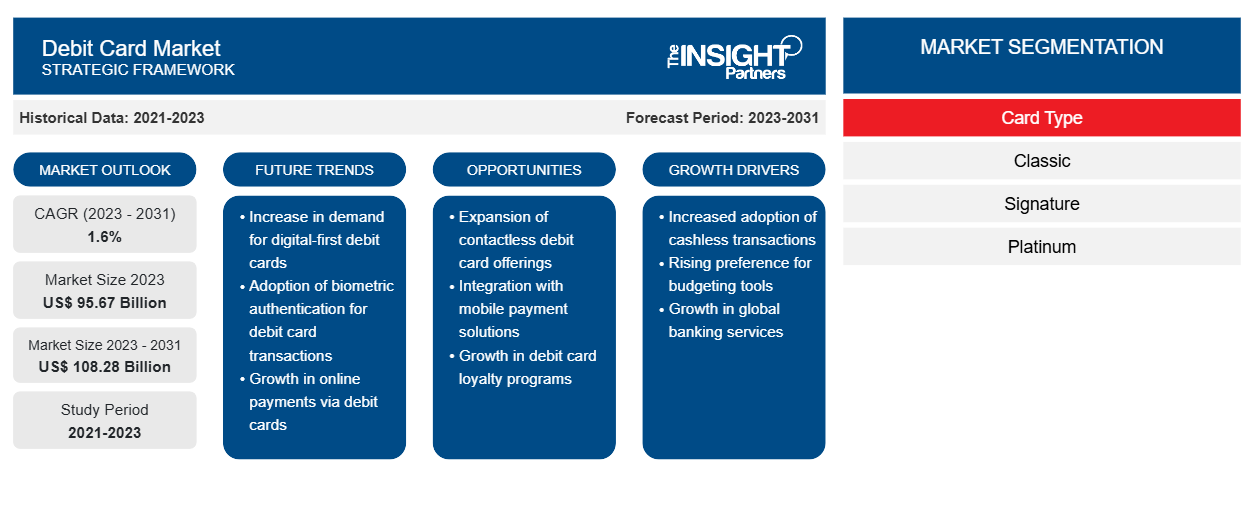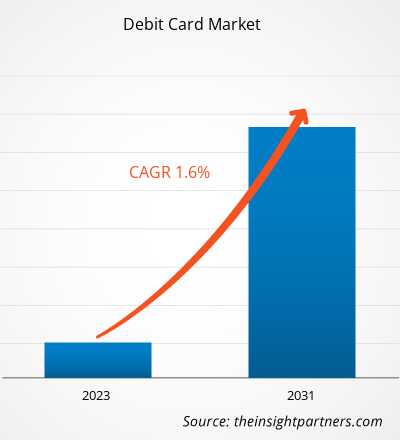その規模は、2023年の956.7億米ドルから2031年には1082.8億米ドルに成長すると予想されており、2023年から2031年にかけて1.6%のCAGRで拡大すると予想されています。
デビットカード市場分析
デビット カード市場の予測は、主要な企業出版物、協会データ、データベースなど、さまざまな二次および一次調査結果に基づいて推定されています。デビット カード市場の成長は、アクセス性と利便性の向上、現金への依存度の減少、銀行口座の普及率の向上、セキュリティ機能の向上、詐欺防止の強化、およびデジタル バンキングシステムとの統合によるものです。
予測期間中に予測される成長は、非接触型決済の導入の拡大、金融包摂の取り組み、政府主導のキャッシュレス化の取り組みの拡大、個人財務管理機能の統合、オンライン支出と電子商取引の成長によるものと考えられます。予測期間中に予想されるデビット カード市場の主な動向には、デジタル通貨の導入、カスタムメイドの予算ツールの開発、改善された詐欺防止策の適用、オープン バンキング システムとの統合、フィンテック企業との合併や提携の形成などがあります。
デビットカード
業界概要
- デビットカード市場の成長は、さまざまな要因による現金の使用量の減少によって促進されています。世界中の政府や機関は、マネーロンダリングのリスクや犯罪の減少、脱税の減少、企業の取引コストの削減などの利点を挙げ、現金取引を最小限に抑えるために積極的に取り組んでいます。たとえば、2021年6月にフィナンシャルタイムズが発表したレポートでは、現金支払いが35.0%減少すると指示されており、デビットカード市場を牽引すると予想されるデジタル支払いへの現在の傾向を強調しています。
- デビットカード市場の大手企業は、顧客基盤を拡大し、収益を増やすために、ステッカーベースのデビットカード製品を導入することで発明を行っています。これらの非接触型デビットカードは、スマートウォッチ、ノートブック、携帯電話など、さまざまなデバイスに貼り付けることができる小さなステッカーの形をしています。たとえば、2022年11月、インドを拠点とする金融機関IDFCは、インド国家決済機構(NPCI)と提携して、インド初のステッカーベースのデビットカードであるFIRSTAPの発売を発表しました。この非接触型テクノロジーは、摩擦のないデジタル取引を提供することを目的としており、顧客中心のソリューションに対する業界の責任を示しています。
要件に合わせてレポートをカスタマイズする
このレポートの一部、国レベルの分析、Excelデータパックなど、あらゆるレポートを無料でカスタマイズできます。また、スタートアップや大学向けのお得なオファーや割引もご利用いただけます。
- このレポートの主要な市場動向を入手してください。この無料サンプルには、市場動向から見積もりや予測に至るまでのデータ分析が含まれます。
デビットカード市場の牽引役
成長する電子商取引業界が市場の成長を牽引
- オンラインショッピングの普及に伴い、顧客はシームレスで安全な取引を容易にするためにデビットカードを選択しています。デビットカードとオンライン決済ゲートウェイの統合により、特にオンラインショッピングへの傾向が強まったポストコロナ時代には、 eコマースの成長がさらに加速しました。驚くべきことに、2022年4月の国連貿易開発会議(UNCTD)によると、2021年のオンライン小売売上高は2.9兆米ドルに達し、その大部分を米国と中国が占めています。このように、eコマース活動の増加は、デビットカード市場の成長を継続的に押し上げています。
デビットカード
市場レポートのセグメンテーション分析
- カードの種類に基づいて、デビットカード市場はクラシック、シグネチャー、プラチナ、ゴールド、その他に分類されます。クラシックセグメントは、2023年にデビットカード市場で大きなシェアを占めました。
- 従来のデビット カードは、銀行が提供する関連特典により、迅速かつ簡単な支払いを可能にします。Rupay、Mastercard、Visa などのさまざまなサービス プロバイダーが、このタイプのデビット カードを提供しています。
デビットカード
市場地域分析
デビット カード市場レポートの範囲は、主に北米、ヨーロッパ、アジア太平洋、中東およびアフリカ、南米の 5 つの地域に分かれています。北米は急速な成長を遂げており、2022 年にはデビット カード市場で注目すべきシェアを占めると予想されています。この成長は、この地域の主要企業の存在によるものです。さらに、アジア太平洋地域は予測期間中に大幅な CAGR で成長すると予想されています。
デビットカード
デビットカード市場の地域別分析
予測期間を通じてデビット カード市場に影響を与える地域的な傾向と要因は、Insight Partners のアナリストによって徹底的に説明されています。このセクションでは、北米、ヨーロッパ、アジア太平洋、中東、アフリカ、南米、中米にわたるデビット カード市場のセグメントと地理についても説明します。

- デビットカード市場の地域別データを入手
デビットカード市場レポートの範囲
| レポート属性 | 詳細 |
|---|---|
| 2023年の市場規模 | 956.7億米ドル |
| 2031年までの市場規模 | 1,082.8億米ドル |
| 世界のCAGR(2023年~2031年) | 1.6% |
| 履歴データ | 2021-2023 |
| 予測期間 | 2023-2031 |
| 対象セグメント | カードタイプ別
|
| 対象地域と国 | 北米
|
| 市場リーダーと主要企業プロフィール |
|
デビットカード市場のプレーヤー密度:ビジネスダイナミクスへの影響を理解する
デビット カード市場は、消費者の嗜好の変化、技術の進歩、製品の利点に対する認識の高まりなどの要因により、エンド ユーザーの需要が高まり、急速に成長しています。需要が高まるにつれて、企業は提供内容を拡大し、消費者のニーズを満たすために革新を起こし、新たなトレンドを活用し、市場の成長をさらに促進しています。
市場プレーヤー密度とは、特定の市場または業界内で活動している企業または会社の分布を指します。これは、特定の市場スペースに、その規模または総市場価値と比較して、どれだけの競合相手 (市場プレーヤー) が存在するかを示します。
デビットカード市場で事業を展開している主要企業は次のとおりです。
- アメリカン・エキスプレス
- バンク・オブ・アメリカ
- トロント・ドミニオン銀行
- サンタンデール銀行
- シティグループ
免責事項:上記の企業は、特定の順序でランク付けされていません。

- デビットカード市場のトップキープレーヤーの概要を入手
「デビットカード市場分析」調査は、カードの種類と地域に基づいて実施されました。カードの種類では、市場は署名、プラチナ、ゴールド、その他に分類されています。地理に基づいて、市場は北米、ヨーロッパ、アジア太平洋、中東およびアフリカ、南米に分類されています。
デビットカード
市場ニュースと最近の動向
デビット カード市場では、企業は合併や買収などの無機的および有機的な戦略を採用しています。最近の主要な市場動向をいくつか以下に示します。
- 2022年9月、米国を拠点とする多国籍投資銀行であるJPモルガンは、次世代の決済処理プラットフォームの開発という目標を推進するために、Renovite Technologiesの買収を発表しました。米国を拠点とする決済ソリューションプロバイダーであるRenovite Technologiesは、決済サービスの強化に関するJPモルガンのビジョンに合致する専門知識をもたらします。
(出典:JPモルガン、企業ウェブサイト)
デビットカード
市場レポートの対象範囲と成果物
市場レポート「デビットカード市場規模と予測(2021〜2031年)」では、以下の分野を網羅した市場の詳細な分析を提供しています。
- 対象範囲に含まれるすべての主要市場セグメントについて、世界、地域、国レベルでの市場規模と予測。
- 推進要因、制約、主要な機会などの市場の動向。
- 今後の主な動向。
- 詳細なPESTおよびSWOT分析
- 主要な市場動向、主要プレーヤー、規制、最近の市場動向を網羅した世界および地域の市場分析。
- 市場集中、ヒートマップ分析、主要プレーヤー、最近の動向を網羅した業界の状況と競争分析。
- 詳細な企業プロフィール。
- 過去2年間の分析、基準年、CAGRによる予測(7年間)
- PEST分析とSWOT分析
- 市場規模価値/数量 - 世界、地域、国
- 業界と競争環境
- Excel データセット


- Integrated Platform Management System Market
- Maritime Analytics Market
- Fixed-Base Operator Market
- Railway Braking System Market
- Sweet Potato Market
- Rare Neurological Disease Treatment Market
- Europe Surety Market
- Employment Screening Services Market
- Aerospace Forging Market
- Military Rubber Tracks Market

Report Coverage
Revenue forecast, Company Analysis, Industry landscape, Growth factors, and Trends

Segment Covered
This text is related
to segments covered.

Regional Scope
North America, Europe, Asia Pacific, Middle East & Africa, South & Central America

Country Scope
This text is related
to country scope.
よくある質問
The key players holding majority shares in the global debit card market are Bank of America Corporation, JPMorgan Chase & Co., PayU Global BV, Banco Santander S.A., and Citigroup Inc.
The global debit card market is expected to reach US$ 108.28 billion by 2031.
The global debit card market was estimated to be US$ 95.67 billion in 2023 and is expected to grow at a CAGR of 1.6% during 2023 - 2031.
Digital advancements in the debit card market to play a significant role in the global debit card market in the coming years.
The growing e-commerce industry and increasing initiatives by market players are the major factors that propel the global debit card market.
Trends and growth analysis reports related to Banking, Financial Services, and Insurance : READ MORE..
- American Express Company
- Bank of America Corporation
- Toronto-Dominion Bank
- Banco Santander S.A.
- Citigroup Inc.
- PayU Global BV
- Wells Fargo & Company
- Capital One Financial Corp.
- JPMorgan Chase & Co.
- Visa Inc.
The Insight Partners performs research in 4 major stages: Data Collection & Secondary Research, Primary Research, Data Analysis and Data Triangulation & Final Review.
- Data Collection and Secondary Research:
As a market research and consulting firm operating from a decade, we have published and advised several client across the globe. First step for any study will start with an assessment of currently available data and insights from existing reports. Further, historical and current market information is collected from Investor Presentations, Annual Reports, SEC Filings, etc., and other information related to company’s performance and market positioning are gathered from Paid Databases (Factiva, Hoovers, and Reuters) and various other publications available in public domain.
Several associations trade associates, technical forums, institutes, societies and organization are accessed to gain technical as well as market related insights through their publications such as research papers, blogs and press releases related to the studies are referred to get cues about the market. Further, white papers, journals, magazines, and other news articles published in last 3 years are scrutinized and analyzed to understand the current market trends.
- Primary Research:
The primarily interview analysis comprise of data obtained from industry participants interview and answers to survey questions gathered by in-house primary team.
For primary research, interviews are conducted with industry experts/CEOs/Marketing Managers/VPs/Subject Matter Experts from both demand and supply side to get a 360-degree view of the market. The primary team conducts several interviews based on the complexity of the markets to understand the various market trends and dynamics which makes research more credible and precise.
A typical research interview fulfils the following functions:
- Provides first-hand information on the market size, market trends, growth trends, competitive landscape, and outlook
- Validates and strengthens in-house secondary research findings
- Develops the analysis team’s expertise and market understanding
Primary research involves email interactions and telephone interviews for each market, category, segment, and sub-segment across geographies. The participants who typically take part in such a process include, but are not limited to:
- Industry participants: VPs, business development managers, market intelligence managers and national sales managers
- Outside experts: Valuation experts, research analysts and key opinion leaders specializing in the electronics and semiconductor industry.
Below is the breakup of our primary respondents by company, designation, and region:

Once we receive the confirmation from primary research sources or primary respondents, we finalize the base year market estimation and forecast the data as per the macroeconomic and microeconomic factors assessed during data collection.
- Data Analysis:
Once data is validated through both secondary as well as primary respondents, we finalize the market estimations by hypothesis formulation and factor analysis at regional and country level.
- Macro-Economic Factor Analysis:
We analyse macroeconomic indicators such the gross domestic product (GDP), increase in the demand for goods and services across industries, technological advancement, regional economic growth, governmental policies, the influence of COVID-19, PEST analysis, and other aspects. This analysis aids in setting benchmarks for various nations/regions and approximating market splits. Additionally, the general trend of the aforementioned components aid in determining the market's development possibilities.
- Country Level Data:
Various factors that are especially aligned to the country are taken into account to determine the market size for a certain area and country, including the presence of vendors, such as headquarters and offices, the country's GDP, demand patterns, and industry growth. To comprehend the market dynamics for the nation, a number of growth variables, inhibitors, application areas, and current market trends are researched. The aforementioned elements aid in determining the country's overall market's growth potential.
- Company Profile:
The “Table of Contents” is formulated by listing and analyzing more than 25 - 30 companies operating in the market ecosystem across geographies. However, we profile only 10 companies as a standard practice in our syndicate reports. These 10 companies comprise leading, emerging, and regional players. Nonetheless, our analysis is not restricted to the 10 listed companies, we also analyze other companies present in the market to develop a holistic view and understand the prevailing trends. The “Company Profiles” section in the report covers key facts, business description, products & services, financial information, SWOT analysis, and key developments. The financial information presented is extracted from the annual reports and official documents of the publicly listed companies. Upon collecting the information for the sections of respective companies, we verify them via various primary sources and then compile the data in respective company profiles. The company level information helps us in deriving the base number as well as in forecasting the market size.
- Developing Base Number:
Aggregation of sales statistics (2020-2022) and macro-economic factor, and other secondary and primary research insights are utilized to arrive at base number and related market shares for 2022. The data gaps are identified in this step and relevant market data is analyzed, collected from paid primary interviews or databases. On finalizing the base year market size, forecasts are developed on the basis of macro-economic, industry and market growth factors and company level analysis.
- Data Triangulation and Final Review:
The market findings and base year market size calculations are validated from supply as well as demand side. Demand side validations are based on macro-economic factor analysis and benchmarks for respective regions and countries. In case of supply side validations, revenues of major companies are estimated (in case not available) based on industry benchmark, approximate number of employees, product portfolio, and primary interviews revenues are gathered. Further revenue from target product/service segment is assessed to avoid overshooting of market statistics. In case of heavy deviations between supply and demand side values, all thes steps are repeated to achieve synchronization.
We follow an iterative model, wherein we share our research findings with Subject Matter Experts (SME’s) and Key Opinion Leaders (KOLs) until consensus view of the market is not formulated – this model negates any drastic deviation in the opinions of experts. Only validated and universally acceptable research findings are quoted in our reports.
We have important check points that we use to validate our research findings – which we call – data triangulation, where we validate the information, we generate from secondary sources with primary interviews and then we re-validate with our internal data bases and Subject matter experts. This comprehensive model enables us to deliver high quality, reliable data in shortest possible time.


 このレポートの無料サンプルを入手する
このレポートの無料サンプルを入手する